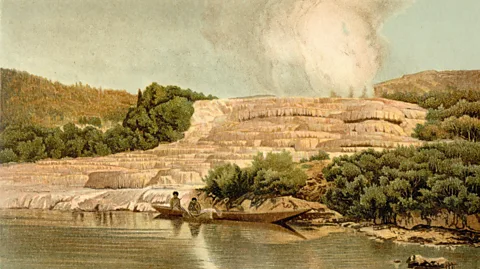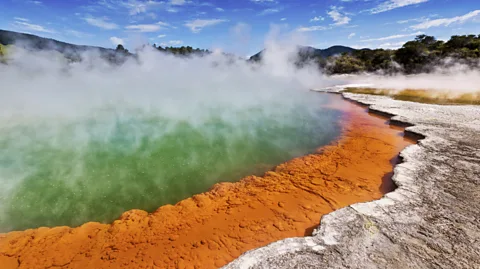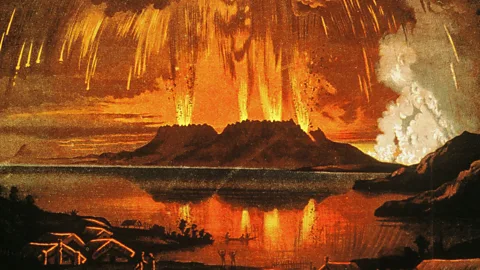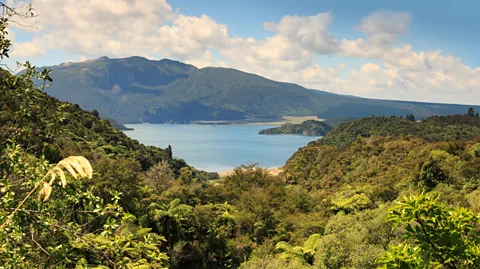The birthplace of New Zealand tourism
 Quagga/Alamy
Quagga/AlamyAlthough New Zealand's Pink and White Terraces were destroyed in a volcanic eruption in 1886, travellers can still explore this bubbling, boiling landscape today.
Once known as "the eighth Wonder of the World", the Pink and White Terraces that cascaded down a hillside in New Zealand's geothermal Rotorua region would have been a spectacular sight to behold. Created by geothermal waters flowing from the Earth's core that crystallised over hundreds of years, the silica terraces formed tumbling pools, staircases and waterfalls that were filled with warm, mineral-rich waters and steeped in historical and cultural significance.
Before the eruption that destroyed them in the late 19th Century, these natural wonders were New Zealand's most famous tourist attraction, luring wealthy travellers from around the world to bathe in the salmon-pink waters of the Te Otukapuarangi (Pink) Terraces ("The fountain of the clouded sky" in Māori); and visit the Te Tarata (White) Terraces (also known as "the tattooed rock" due to the patterns created by the crystallised silica), which covered seven acres and descended 30m into Lake Rotomahana.
People were also drawn by the tantalising health benefits of the world's youngest geothermal valley's healing waters, famed to aid arthritis, rheumatics, eczema and other debilitating skin conditions.
It wouldn't have been an easy trip to get there – intrepid travellers had to undergo a 75-day sea voyage from Britain to New Zealand, followed by a 200km steam train trip from Auckland to Tauranga and a horse-drawn carriage ride to Lake Rotomahana via Rotorua.
But these enormous silica terraces would have been a truly impressive sight for these adventurous tourists, who ired the tiers of basins, gazed in awe at the boiling geysers and climbed up the hillsides to have their photos taken and pictures painted for posterity.
They were welcomed by the women of Rotorua's Tūhourangi tribe of Te Arawa Māori, who have occupied this volcanic valley since 1325 and who guided the international visitors by waka (canoe) to the terraces. This was the birthplace of international tourism in New Zealand, and these Māori were New Zealand's first tour guides.
 Jesper Bülow/Getty Images
Jesper Bülow/Getty ImagesThe original female tourism guides won the hearts of visitors with their grace, intelligence and warm hospitality. One guide, Sophia Hinerangi-Gray, also known as Guide Sophia, became the most famous woman in Rotorua and established a reputation not only as the principal guide to the Pink and White Terraces, but also as an educated philosopher and trusted friend to thousands of tourists. She was a role model in her community and encouraged local women to also become financially independent through their work as guides.
"I believe Sophia and all our tribal guides, who were all women, are to be ired," said Karen Walmsley, head guide at Totally Tarawera, a family-owned Tūhourangi business in the greater Rotorua region. Guide Sophia was not only her role model, but her kuia (ancestral grandmother). "These wonderful Māori women managed their whanau (family), work and tribal commitments with grace and were known for their organisational and entrepreneurial skills, their tenacity and for hosting with care people of many different cultures from all over the world."
You may also be interested in:
• An ancient way to save the Earth
David Blackmore, general manager at eco-tourism provider Waimangu Volcanic Valley, which covers the region where the Pink and White Terraces were located, agrees: "The early tour guides were innovative, ground-breaking, hospitable, entrepreneurial and hard working. Visitors coming to the Tarawera/Rotorua area were New Zealand's first tourists, so they really led the way."
The guides had a strong spiritual connection to the land and a deep desire to look after it. Blackmore's team of local Te Awara guides still abides by three values that he says were very apparent in the early tourism efforts of guides such as Sophia. These are manaakitanga (welcoming, sharing valued time together), whanaungatanga (respect for each other and openness) and kaitiakitanga (looking after this special place in the world).
"Although it was a natural phenomenon and designated the eighth Wonder of the World, that's not how our people saw it – we knew nothing about other countries at that time and our concerns were about taking care of the land," said Walmsley.
However, the openness to invite others in and the responsibility to care for the land were sometimes at odds. In 1886, on a guiding tour to the Terraces, Guide Sophia witnessed a dire premonition of impending tragedy when she saw the water level in the lake dip sharply and then rise again. Historical records make note of her hearing an "eerie whimpering sound" shortly afterwards.
 Waimangu Volcanic Valley
Waimangu Volcanic ValleyAs the story goes, she then noticed a phantom canoe with a sole paddler. As the canoe came closer, she saw it had a crew of 13, each with a dog's head. These visions were seen as an omen and warning; a foreboding sign that ancestors were unhappy at the exploitation of their culture and healing powers of the land for monetary gain.
The next day, on 10 June 1886, the so-called eighth Wonder of the World was destroyed when a volcanic eruption at Mount Tarawera shook the lands, and Te Wairoa, the village founded in 1848 to service tourists, was buried under choking layers of scoria, ash and mud. More than 150 people lost their lives and the terraces were swallowed by a 100m-deep crater caused by the blast, which later filled to form a new Lake Rotomahana, 10 times larger and deeper than the old lake.
Although the terraces are now gone, travellers can still explore this geologically fascinating landscape, often guided by descendants of the original Te Arawa tour guides, such as Warmsley, who are continuing this legacy of hospitality and sharing of culture.
Halfway between Rotorua and Waimangu Volcanic Valley, is Te Wairoa, now known as the Buried Village, whose archaeological sites have been excavated to the original floor levels and show the depth of mud and volcanic ash that ejected upon the village, and visitors can hear personal s of the eruption on a guided tour.
At Waimangu Volcanic Valley, travellers can retrace the journey Guide Sophia took through the geothermal valley and follow in the footsteps of the first tourists, uncovering the stories of the Pink and White Terraces and the Tarawera eruption, and seeing the geothermal attractions and stunning crater lakes uncovered by the blast.
Technology is also bringing the Pink and White Terraces back to life through the augmented reality Waimangu app, which was launched in December 2018. Using a slider feature that compares the present-day views to how the scenery looked back in the 1800s, travellers can experience the size, scale and beauty of the natural wonder for themselves while immersed in the real-life bubbling, boiling landscape sights and smells.
 Jon Lovette/Getty Images
Jon Lovette/Getty Images"For New Zealanders, almost all of us learnt about the famous Pink and White Terraces at school," said Blackmore. "The fact you can now revisit and see and touch and smell and feel the area makes the augmented reality experience very compelling."
Walmsley offers guests her own, personal insights into this geothermal wonderland, honouring the traditions of her ancestors by demonstrating how to use the hot sand and naturally boiling water to cook. She tells guests about the healing waters, which are still attracting tourists to soak in natural hot pools in the bush around Mount Tarawera, where the Tūhourangi people have lived for many generations.
"The geothermal waters still help ease ailments and leaves skin soft," said Walmsley. "In Guide Sophia's time, our people allowed visitors to come as long as they were under our guidance – we knew the geothermal waters were dangerous if care was not taken, and we're still helping to guide them today in the same way."
And, as Blackmore says, you don't even need to bathe in the water to feel the healing powers: "People who visit the spot where the Terraces were always tell us the same thing. They tell us they feel something very special here."
Travel Journeys is a BBC Travel series that transports you to some of the most breathtaking landscapes, far-flung locations and fascinating cultures on Earth.
--
more than three million BBC Travel fans by liking us on Facebook, or follow us on Twitter and Instagram.
If you liked this story, sign up for the weekly bbc.com features newsletter called "The Essential List". A handpicked selection of stories from BBC Future, Culture, Worklife and Travel, delivered to your inbox every Friday.
{"image":{"pid":""}}
